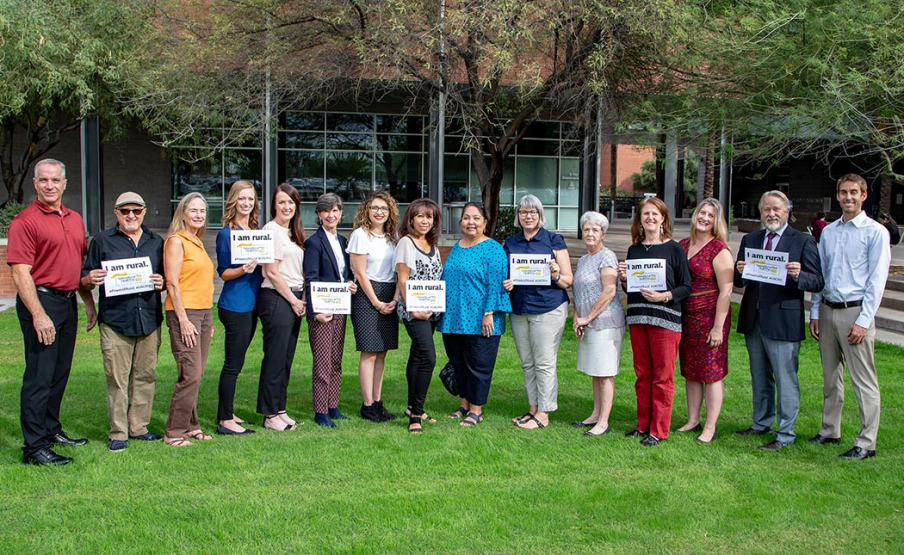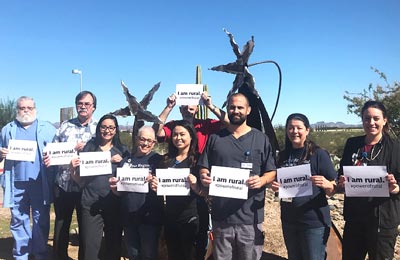Faculty and staff of the Center for Rural Health at the UA Mel and Enid Zuckerman College of Public Health. From Left, Rod Gorrell, Paul Akmajian, Susan Coates, Amy McPherson, Melissa Quezada, Joyce Hospodar, Melissa Quezada, Rebecca Ruiz, Agnes Attakai, Jennifer Peters, Sharon Van Skiver, Jill Bullock, Hillary Evans, Daniel Derksen, and Marc Verhougstraete. Other staff missing from the photo: Heather Carter and Alyssa Padilla.
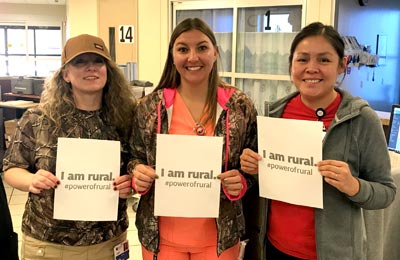
Rural communities are wonderful places to live and work. Of the 7 million people living in Arizona, an estimated 347,797 call rural communities their home. These small towns are places where neighbors know and respect each other and work together to benefit the greater good.
Arizona's rural communities also have unique healthcare needs. Today more than ever, rural communities must address accessibility issues, a lack of healthcare providers, the needs of an aging population suffering from a greater number of chronic conditions, and larger percentages of uninsured and underinsured.
“Arizonans living in rural and frontier areas of the state need ready access to health services, and better connections to urban health systems. Rural Health Day focuses attention both on the unmet needs and the innovative health programs and services provided in our rural communities,” said Daniel Derksen, MD, director of the Arizona Center for Rural Health and associate vice president for Health Equity, Outreach & Interprofessional Activities at the University of Arizona Health Sciences.
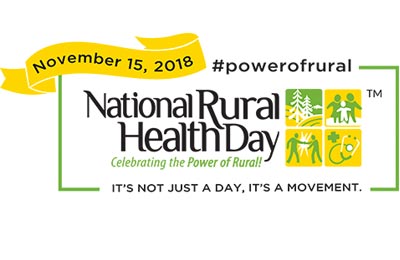
For the past 37 years, the Arizona Center for Rural Health (AzCRH) at the University of Arizona Mel and Enid Zuckerman College of Public Health, has been serving the state through its core mission to improve the health and wellness of the state's rural and underserved populations.
To celebrate National Rural Health Day on Thursday, Nov. 15, the Arizona Center for Rural Health will host a Live Webinar, Growing the Power of Rural: The Rural Health Workforce in Arizona, from 12 p.m. to 1 p.m.
The Presenters:
- Heather Carter, EdD, assistant professor of practice, UA Mel and Enid Zuckerman College of Public Health and associate director of the Arizona Center for Rural Health. She also serves in the Arizona House of Representatives, from North Phoenix and currently chairs the Health Committee.
- Sean Clendaniel serves as Quality and Clinical Manager at the Collaborative Ventures Network. He also holds academic appointments and is actively involved with various governing and advisory boards and committees.
- Daniel Derksen, MD, associate vice president for Health Equity, Outreach & Interprofessional Activities, UA Health Sciences, professor of public health, UA Mel and Enid Zuckerman College of Public Health.
- Ana Roscetti, workforce section manager for the Arizona Department of Health Services, Bureau of Women’s and Children’s Health Arizona Primary Care Office.
To register for the webinar, visit: http://www.telemedicine.arizona.edu
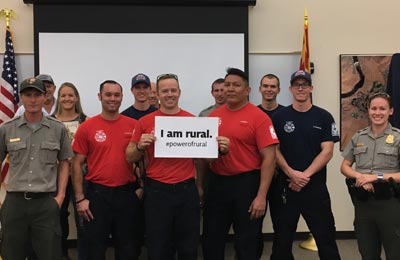
Visit the "I am rural" Photo Gallery to see the faces of the many doctors, nurses, firefighters, police, administrators and staff of the hospitals and community health centers we serve. From Page to Winslow and Sacaton to La Paz County, we celebrate the people of rural Arizona.
The Arizona Center for Rural Health is home to the State Office of Rural Health, and many programs including, the Rural Hospital Flexibility Program, the Small Rural Hospital Improvement Program, Arizona First Responders Initiative, Health Insurance Assistance, Students Helping Arizona Register Everyone (SHARE), and the Prescription Drug Misuse & Abuse Initiative.
The Center for Rural Health serves rural Arizona by:
- Providing education, technical assistance, data and analysis to rural partners, hospitals, and providers to help them adapt to the rapidly changing rural health environment and address unmet rural health needs.
- Training, recruiting and retaining health professionals for rural practice.
- Collecting, synthesizing and disseminating data to inform providers, policymakers and consumers about legislation, regulation, programs and grant opportunities to improve rural health access and outcomes.
Following is an overview of the many programs and collaborations highlighted in the Arizona Center for Rural Health 2017-2018 Annual Report.
The AzCRH is federally designated as the Arizona State Office of Rural Health that helps rural communities build and sustain health services and address rural health needs.
The Arizona Center for Rural Health hosts two annual statewide meetings: the Arizona Rural Health Conference during the summer and the Arizona Rural & Public Health Policy Forum at the state capitol.
Arizona Rural Hospital Flexibility Program (AzFlex): The AzCRH works on fiscal and quality improvement with Arizona’s 15 federally designated Critical Access Hospitals (CAHs). These are small rural hospitals – 25 beds or less, with a 24/7 emergency department, and 35 miles or more from another facility.
Arizona First Responders Initiative: In the midst of statewide and national opioid public health emergencies, the AzCRH and the Arizona Department of Health Services partners on a four-year, $3.1 million Substance Abuse and Mental Health Services Administration grant to train first responders to recognize the symptoms of opioid abuse and to administer naloxone, a drug used to counter the effects of opioid overdose and save lives. The program also covers screening, brief intervention and referral to services for those with opioid use disorder.
Prescription Drug Misuse and Abuse Initiative: The AzCRH works with the Arizona Department of Health Services and the UA College of Medicine, Office of Continuing Medical Education to create and disseminate substance misuse and opioid-related free online Continuing Medical Education (CME) modules targeted to physicians and other providers licensed to prescribe controlled substances in Arizona.
Students Helping Arizona Register Everyone (Project SHARE): UA was designated a White House Healthy Campus Challenge winner for 2016-17 efforts to engage students in the health coverage eligibility, enrollment, and education in collaboration with UA Campus Health. The AzCRH 2018-19 Project SHARE cohort trains UA Health Sciences students from the Colleges of Medicine, Nursing, Pharmacy and Public Health to be Certified Assisters. Students learn about the U.S. health system, public (Medicaid, Medicare, Children's Health Insurance Program (CHIP) and private payers (Arizona Marketplace), the Affordable Care Act, and other programs, laws, and regulations that affect how Arizonans are covered and access health services.
The The AzCRH Internship Program provides opportunities for health professional undergraduate and graduate student internship and dissertation projects in Arizona’s rural and urban underserved areas.

The Arizona Rural Recruitment and Retention Network (AZ3RNet) manages the state’s rural recruitment and retention network for healthcare professionals. Working in partnership with the Arizona Department of Health Services Bureau of Health Systems Development and Arizona Alliance for Community Health Centers, the Az3RNet connects health professionals seeking positions in rural and underserved areas with health facilities offering employment opportunities.
The Arizona Small Rural Hospital Improvement Program helps small rural hospitals under 50 beds meet goals under value-based purchasing, accountable care organization/shared savings programs, and purchasing equipment/training to comply with meaningful use, ICD-10 standards, and payment bundling.
Tribal Health Initiatives: The AzCRH collaborates with Arizona's 22 sovereign tribal nations and rural non-profit organizations to improve health outcomes and wellbeing by strengthening the American Indian health professional pipeline, building capacity in health promotion and disease prevention interventions, and training health educators and community outreach workers on multi-media health literacy and communication methods.
The Rural Health Professions Program supports the development and delivery of service learning courses providing opportunities for our master of public health and doctoral students to participate in service learning courses and activities throughout Arizona. Community-engaged experiences provide the framework for understanding the assets and issues of our rural and underserved communities.
For more information about the Arizona Center for Rural Health, visit www.crh.arizona.edu.






